There are 12 native snakes in Idaho and include a wide varitey from Garter Snakes to Rattlesnakes.
If you are planning on keeping a snake in Idaho, you must know the law and whether or not the species you are hoping for can be kept in your state.
In Idaho, most species are illegal to own in the capital city, Boise, which bans all venomous snakes excluding those that are native to the United States. The rest of the cities of the state require owners to have an import permit as well as a veterinary certificate of health in order to own a snake.
Table of Contents
Common Snake Species in Idaho
Here are some common snakes that roam the state:
1. North American Racer
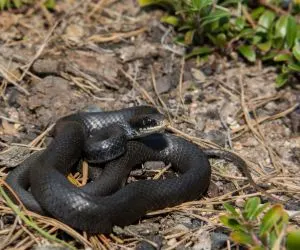
- Experience Level: Intermediate
- Family: Colubridae
- Scientific Name: Coluber constrictor
- Other Names: Black Racer, Racer, North American Blue Racer
- Adult Size: Anywhere from 20 to 65 inches
- Lifespan: 10 years
These slender snakes are versatile and are not dangerous or venomous. They are called racers because they are very fast-moving.
They are mostly docile creatures. However, if they feel threatened, they are ready to defend themselves. In most cases, it can be quite hard for these snakes to become accustomed to handling.
These snakes are silvery-grey and can sometimes be an almost metallic-looking electric blue. North American Racers will have a pale yellow or white underside and a black tongue.
A bite from them is shocking but harmless to humans or larger pets like dogs or cats.
They inhabit young or regrowing forest edges and shrubland. These Racers feed on small mammals, insects, smaller snakes, and lizards by swallowing them alive.
2. Gophersnake
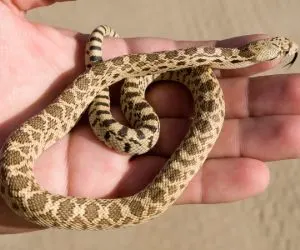
- Experience Level: Intermediate
- Family: Colubridae
- Scientific Name: Pituophis catenifer
- Other Names: Gopher Snake
- Adult Size: 4 to 7 feet; can reach up to 9 feet
- Lifespan: 12 to 15 years; up to 30 years in captivity
The Gopher Snake is very heavy-bodied and is quite long in length. They are pretty docile creatures except when threatened.
These guys will require a very secure enclosure as they are escape artists. They also require a lot of space due to their size and active nature.
Gopher snakes are usually a light tan to brown color with large, dark brown, sometimes reddish-brown spots and lined patterns throughout their length. Sometimes they are mistaken for rattlesnakes, but you would just have to identify them by their lack of a rattler.
They can be found in Idaho’s Boise Foothills, where they inhabit warm, dry, forested areas.
They really like to eat small rodents, which is actually how they got their name. They help keep the rodent population down in whatever area they roam.
3. Terrestrial Garter Snake

- Experience Level: Beginner
- Family: Colubridae
- Scientific Name: Thamnophis elegans vagrans
- Other Names: Wandering Garter Snake
- Adult Size: 18 to 43 inches
- Lifespan: 6 to 12 years in captivity; 2 years in the wild
Wandering Garter Snakes are typically gray or gray-brown covered in a black checkered pattern and three cream-colored stripes running down the top and sides of their body.
They are the most common aquatic snakes in the state of Idaho.
They prefer to inhabit riparian habitats as well as any other areas with moist climates like lakes, ponds, and wet meadows. You can also find them in sagebrush and coniferous forests.
They will hunt for fish, mollusks, tadpoles, and amphibians in water but will also eat insects like grasshoppers, as well as small vertebrates like birds, reptiles, and mice.
4. Common Garter Snake
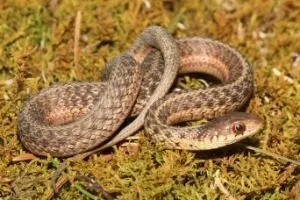
- Experience Level: Beginner
- Family: Colubridae
- Scientific Name: Thamnophis sirtalis
- Other Names: Garter Snake
- Adult Size: 23 to 30 inches; some can grow to 5 feet
- Lifespan: 4 to 5 years in the wild; up to 10 years in captivity
Common Garter Snakes are completely harmless to humans.
These guys are usually relatively small and like to remain active during the day. These guys like to soak often, so they will require a bowl in their tank for them to soak in, especially when it comes time to shed.
Garter snakes are great snakes for beginners since they are docile and will not grow to be too large.
Common Garter Snakes can range from dark olive-green to brown or black with a distinctive yellow stripe running throughout the length of their body.
When threatened, they may let off a musk in order to ward off predators. They can be found in many places like marshes, woodlands, meadows, or hillsides.
These snakes feed on leeches, slugs, worms, small fish, amphibians, and even other snakes. They are also immune to toxic frogs that secrete toxins from their skin in order to drive away prey.
5. Northern Rubber Boa
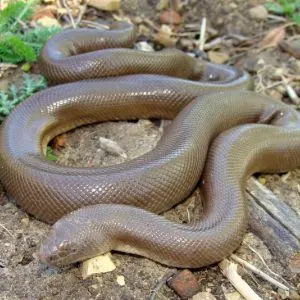
- Experience Level: Beginner
- Family: Boidae
- Scientific Name: Charina bottae
- Other Names: Coastal Rubber Boa
- Adult Size: 14 to 33 inches
- Lifespan: 30 years
These snakes are slow-moving and like sitting around in our warm hands and arms. They are friendly and might actually enjoy being handled.
They get their name from their rubbery skin, which you will notice if you ever hold one. It does feel similar to rubber, but a lot softer.
These snakes come in a tan to grey or brown color tone. Their skin is shiny and their head is quite uniform to the rest of their girth.
They can be found in a range of habitats from coniferous forests to desert lands, but are rarely encountered by humans.
They eat mice and other small mammals, even sometimes feasting on tinier snakes or lizard eggs.
6. Ring-necked Snake
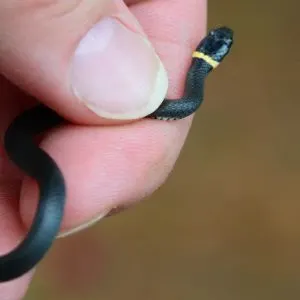
- Experience Level: Intermediate
- Family: Colubridae
- Scientific Name: Diadophis punctatus
- Other Names: Ringneck Snake
- Adult Size: 10 to 15 inches
- Lifespan: 20 years in the wild; 6 years in captivity
Ringneck Snakes have slender bodies and smooth scales, ranging from black, bluish-black, greenish-gray, to olive in color. Their undersides will usually be yellow, orange, or red with a ring around their neck of the same color.
You can find these snakes in a wide variety of habitats as long as there is a lot of places for them to hide and take cover. They like making dens under woody debris.
They typically feed on terrestrial worms, mollusks, and amphibians.
7. Desert Night Snake

- Experience Level: Intermediate
- Family: Colubridae
- Scientific Name: Hypsiglena torquata
- Other Names: Nightsnake
- Adult Size: 26 inches
- Lifespan: 12 years in captivity; Wild unknown
You can identify these snakes with their tan or light gray color and dark brown or gray blotches. They have smooth dorsal scales and their undersides are unmarked.
They have copper eyes with a vertically elliptical pupil.
They are known to be slightly venomous; just enough to subdue their tiny prey, but are mostly harmless to humans and take well to handling.
You can find them in semi-arid areas with rocky dirt or soil since that is their preference. They like to hide under rocks until it comes time for them to come out at night.
In this habitat, they eat mostly smaller snakes and soft insects without an exoskeleton. They will also eat amphibians or smaller lizards and snakes.
8. Western Ground Snake
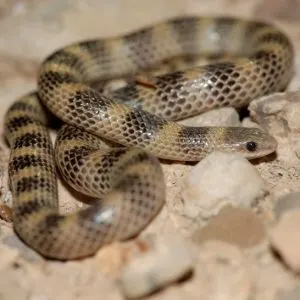
- Experience Level: Beginner
- Family: Colubridae
- Scientific Name: Sonora semiannulata
- Other Names: Variable Ground Snake, Ground Snake, Common Ground Snake
- Adult Size: 8 to 19 inches
- Lifespan: estimated 15 years
Ground Snakes will vary in color depending on the individual. Some may be brown, red, or orange. They will usually have a black banding with orange or brown blotches that look like stripes.
Their undersides are solid white or gray. They have smooth scales, round pupils, and a smaller head.
They like to inhabit arid environments that have loose, sandy soil or rocky areas like low desert shrubbery, rims of canyons, outcroppings, and slopes.
This species can mostly be found near the Snake River in Owyhee County.
It is hard to run into these snakes since they are always hiding in debris, but they will usually come out when the sun is about to set. They have been spotted on desert roads before.
Ground Snakes eat invertebrates like spiders, centipedes, crickets, scorpions, and larvae.
9. Long-nosed Snake
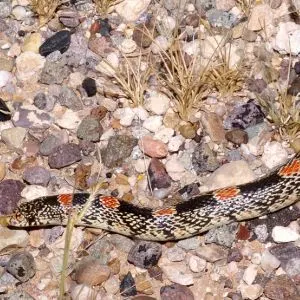
- Experience Level: Expert
- Family: Colubridae
- Scientific Name: Rhinocheilus lecontei
- Other Names: Longnose Snake
- Adult Size: 30 to 40 inches
- Lifespan: less than 20 years
Long-nosed Snakes are not commonly found in the pet trade because they are difficult to keep since they are notorious escape artists.
They get their name from their slightly upturned, long snout somewhat resembling a shark nose.
They look very similar to a Coral Snake or Milk Snakes with their black and red-orange stripe-like pattern except Long-nosed snakes will have somewhat faded-looking sides which are almost a checkered pattern of the same colors as their body. They also have a light yellow or cream-colored body, which looks like a background under other colors.
These nocturnal beings like arid environments such as deserts and dry prairies where they burrow during the day and crawl on cool roads at night.
In Idaho, they can be found along the Snake River in Owyhee County.
These snakes feed primarily on amphibians and lizards but will sometimes be caught eating other smaller snakes and the occasional rodent.
10. Striped Whipsnake
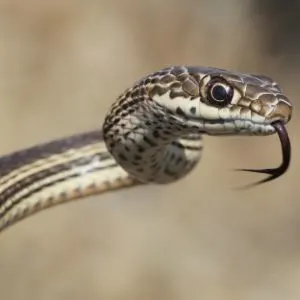
- Experience Level: Expert
- Family: Colubridae
- Scientific Name: Coluber Masticophis taeniatus taeniatus
- Other Names: Desert Striped Whipsnake
- Adult Size: 24 to 67 inches
- Lifespan: anywhere from 10 to 20 years
Related to the North American Racer, Desert Striped Whipsnakes are typically black, dark brown, or gray in color with a blue or olive tint to their skin. They have two pale yellow stripes along their backsides all throughout their length.
Their undersides are usually pale yellow or cream from the head fading into a coral red toward the tail.
They can be found in various habitats such as grasslands, canyons, sagebrush flats, shrublands, pine-oak forests, and juniper woodlands. However, they typically prefer rocky streams, mountains, and flatlands.
This species of snake eats smaller mammals, birds, their eggs, amphibians, other snakes including rattlesnakes, and insects.
Venomous Snake Species in Idaho
Here is a list of the most venomous snakes that roam the state:
11. Western Rattlesnake
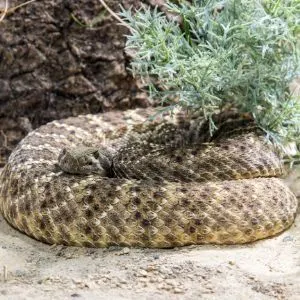
- Experience Level: Expert
- Family: Viperidae
- Scientific Name: Crotalus atrox
- Other Names: Western Diamondback Rattlesnake
- Adult Size: up to 5 feet
- Lifespan: 15 to 20 years
Western Rattlesnakes are typically dusty gray or brown with some pink-brown, brick red, yellow, chalky white, or pink. They also have dark gray or brown dorsal blotches throughout their body.
They have a triangular head and are heavy-bodied. Since it is, indeed a rattlesnake, we can’t forget to mention that it has a rattle at the end of its tail! This species has black and white stripes right underneath it, too.
These guys aren’t that picky about where they live and can be found in rocky areas seeking shade under rocks or other debris. They can also swim, which makes it possible to find them around water as well.
They feed on small mammals like prairie dogs, gophers, squirrels, rabbits, chipmunks, mice, and rats. They might also eat a bird if it comes within its reach.
12. Prairie Rattlesnake

- Experience Level: Expert
- Family: Viperidae
- Scientific Name: Crotalus viridis
- Other Names: Western Rattlesnake, Great Plains Rattlesnake
- Adult Size: 5 feet
- Lifespan: 16 to 20 years in the wild; 24 years max in captivity
If you suffer a bite from this viper and don’t get it treated, it can be very dangerous, and even fatal.
This venomous pit viper is a tan, hefty rattlesnake with dark brown blotches or bands along their backsides, splitting into dark olive or brown rings at their tail.
They can be spotted in sagebrush, grasslands, and high rocky ledges. Prairie Rattlesnakes mostly consume various kinds of rodents like prairie dogs and rabbits.
FAQ
What kind of snakes live in Idaho?
There are 12 common species of snakes that are non-venomous or slightly venomous and only 2 that are venomous, both being rattlesnakes.
Do snakes hibernate in Idaho?
Snakes do not hibernate, but they will brumate. If a snake is in temperatures below 60 degrees Fahrenheit, it will become sluggish and less active.
What venomous snakes are in Idaho?
There are two venomous snakes in Idaho; the Prairie Rattlesnake and Western Rattlesnake.
Are there any rattlesnakes in Idaho?
Yes, the Western Rattler is quite common throughout the state along with Idaho’s second rattler species, the Prairie Rattlesnake.
What time of year do rattlesnakes come out in Idaho?
Rattlesnakes will start to emerge in search of food around late springtime.
What is the most deadliest snake in Idaho?
The deadliest snake in Idaho is the Western Rattlesnake.
Conclusion
Whether you live in Idaho or are just curious about what snakes roam the state, we hope that you learned something interesting from this article.
Idaho has a lot of great snake species to check out, some that can even make suitable pets. If you are planning to get one as a pet, be sure to check out reputable sellers and breeders.
Captive-bred snakes are the best way to go if you are planning to keep one as a pet to avoid snakes with health issues.
Leave a comment down below about what you think or let us know of any questions you might have!
References

Kevin
Thursday 26th of May 2022
Idaho does not have western Diamondback Rattlesnakes, They have Prairie rattle snakes( as mentioned) and the great basin version of the norther pacific rattlesnake Crotalus_oreganus